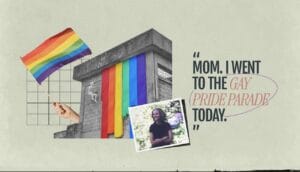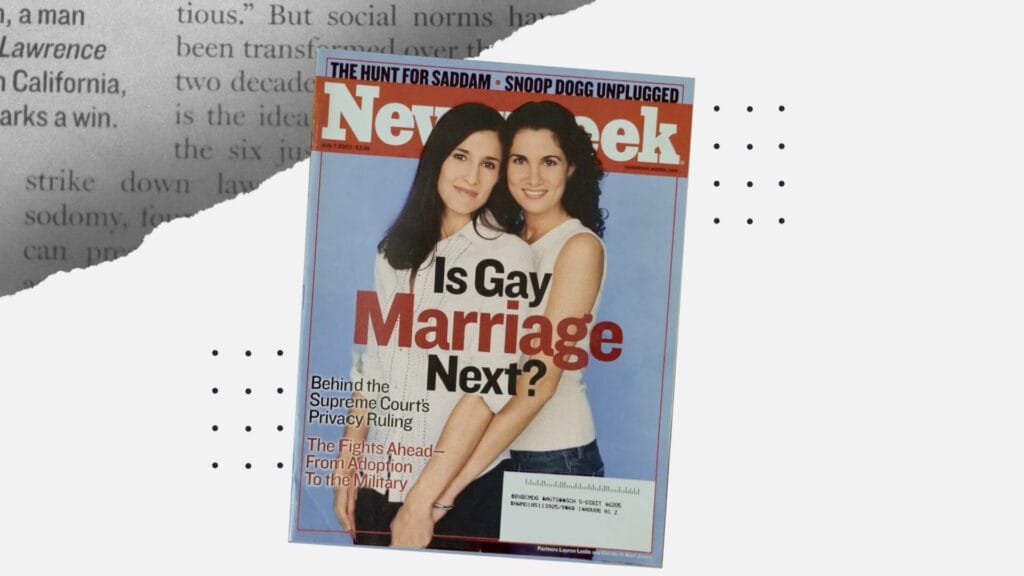Emily Clark’s poignant short documentary, Is Gay Marriage Next?, is a masterclass in intertwining the personal and the political. It offers a deeply intimate narrative that reflects the broader cultural shifts surrounding LGBTQ+ rights in America. Inspired by a 2003 Newsweek cover featuring a lesbian couple—a groundbreaking revelation at the time—Clark’s film is a profound journey of self-discovery, gratitude, and an urgent call to safeguard hard-won progress amid a precarious political landscape.
The film opens with Clark narrating her own coming out story, recounting how that iconic cover “gave [her] hope that a normal life was possible.” A month later, she came out—a powerful testament to the transformative power of representation. The cover itself was a watershed moment, published in the wake of Lawrence v. Texas, the Supreme Court decision that struck down sodomy laws nationwide. It became both a mirror for LGBTQ+ individuals longing for visibility and a catalyst for Clark’s own self-acceptance.
At the heart of the film is Clark’s journey to locate and interview the women featured on the cover, Lauren Leslie and Elisabeth Noel Jones. They share their experiences of being thrust into the spotlight at a time when same-sex intercourse remained illegal in four states, and marriage equality was still a distant dream. Elisabeth reflects on the pain of familial rejection after her coming out: “It wasn’t received well… it was like full-on rejection.” Yet their resilience is undeniable. Over time, the couple transitioned from partners to spouses and eventually co-parents to their non-binary child, Beckett. Their heartfelt plea to parents—”Love your children, embrace them for who they are because they will tell you who they are”—resonates as both a tender affirmation and a powerful rallying cry.
Clark skillfully juxtaposes the hopefulness of the early 2000s with the stark realities of today, highlighting how fragile progress can be. To illustrate this, the film delves into the seismic event of the Supreme Court overturning Roe v. Wade in June 2022. At one point, Clark’s narration pivots sharply to Justice Clarence Thomas’s chilling past remarks about revisiting other “erroneously decided decisions,” ominously suggesting the potential revocation of another fundamental right- the right to same-sex marriage. Ultimately, this leaves the audience with a question that feels more important than ever: Is gay marriage next?
As the film shifts between past and present, Clark’s artistic choices elevate the film’s overall impact. The use of textured, paper-cut animations reminiscent of vintage Newsweek issues lends a historical depth to the narrative. However, the most poignant moments arise in her emotional exchanges with Lauren and Elisabeth. In a heartfelt scene, Clark breaks down as she expresses her gratitude, saying, “As a gay kid who didn’t want to be gay, having you set the example that there was hope in the universe for me… you saved me.”
I had the privilege of sitting down with Emily to discuss the making of this powerful documentary, the challenges she faced, and what this deeply personal journey has meant to her as both a filmmaker and an advocate. Check out our discussion below.

GLAAD: This documentary is deeply personal to you, weaving together your own coming out story with the lives of others. How did your own experiences growing up and discovering your identity influence the storytelling and narrative choices in Is Gay Marriage Next?
Emily: It’s really incredible to witness kids coming out younger and younger. I was 19 when I came out, which felt young in 2003, but I missed many of the typical milestones my straight friends experienced, like dating in high school. I think a lot of LGBTQ millennials and older generations share this sense of missing out, and part of making this film was revisiting those feelings by confronting the self-loathing and pain of that period. I also came out when George Bush was loudly defining what marriage “should” be. And now he’s friends with Ellen, I guess? (Sidenote for George: we haven’t forgotten!)
GLAAD: You mention the powerful impact of seeing a lesbian couple on the cover of Newsweek—how did that representation give you hope, and how does that experience inform the importance of visibility for LGBTQ+ individuals in the media, especially in today’s climate?
Emily: Seeing Lauren and Elisabeth on the cover was like looking in the mirror for the first time—I finally saw who I could be. It was a profound (and terrifying and exhilarating) moment where I felt like these women I’d never met were giving me access to a world I hadn’t yet seen for myself. We often simplify this huge swirl of feelings to “the importance of representation,” but it is so much more than that. It’s about seeing a different kind of life and knowing for the first time that it’s possible for you, too. Now that I work in advertising, I bring this sensibility into every project, because I don’t believe it’s “just an ad” when I know firsthand that an image can change your life.

GLAAD: With the resurgence of cultural battles and the potential threat to gay marriage in the aftermath of recent political shifts, how do you see the legal and cultural landscape changing?
Emily: I was hoping that after November 5th this film would immediately feel dated. Turns out it’s extremely relevant. It’s a really disheartening time for every American who values LGBTQ rights, knowing that the Supreme Court is once again at the mercy of someone who will revel in appointing anti-LGBTQ justices. It’s painful to see our community consulting lawyers about protecting rights that suddenly feel fragile. I know people are tired of fighting, but that’s also a message in the film—we have to find it within ourselves to continue what the people before us started. My way of doing this is through gratitude: the only way we can truly thank the people who got us here is to keep going.
GLAAD: Is Gay Marriage Next? is both a deeply personal story and a historical exploration, and your creative choices reflect that complexity. Can you talk about the specific visual style and techniques you used to blend personal narration with the broader cultural context? Were there particular moments in the film that felt challenging to capture, and how did you decide to bring them to life on screen?
Emily: I don’t have a lot of pictures from my childhood, so I had to get creative. I collaborated with animators in India who helped me bring my story to life with a textured paper look, echoing the feel of a vintage Newsweek print issue. I love my New Delhi-based team. And this topic is also relevant in India, where just last year their Supreme Court ruled against a case that would have made same-sex marriage legal. The most challenging parts to figure out were the personal moments where I thank Lauren and Elisabeth for what they unknowingly did for me by saying “yes” to being on the cover of Newsweek 21 years ago. Turns out it’s really hard to create art out of your own pain and not come across as self-serving or obnoxious… so I worked that section to make sure it felt universal even though it was my voice and story. I wanted my vulnerability to open the door for people to see themselves.

GLAAD: The film ends with a poignant reminder that progress is never guaranteed. With over 750 anti-LGBTQ bills being introduced this year and Supreme Court comments that could jeopardize same-sex marriage rights, what do you think the future holds? How do you navigate a sense of hope and resilience amidst this rising tide of opposition?
I think the best plan right now is to take the long view… zoom out and look at this current moment as exactly that: a moment that will lead to something else. What that ‘something else’ is depends on all of us finding the willpower to defend our people. It’s going to take imagination, creativity, and a ton of resilience, but who better to deliver on that than the funny, beautiful, determined, and courageous LGBTQ community? Am I sucking up? Yes. We need each other more than ever.
GLAAD: So what can people expect next from you?
There is one thing that is scientifically proven to make people happier, and that is gratitude. I would love to turn this short into a series about thanking people who changed your life without knowing it. I also recognize this is a privileged story in many ways—about having rights at risk of being taken away. Meanwhile, we live in a country where trans people are actively discriminated against at every level, who are still fighting for basic dignity. Trans representation is critical all the time and particularly in such a cruel atmosphere. Lastly, as a filmmaker who has benefited from a lot of therapy, the best I can do is tell human stories that in their own small way help the audience find a bit of peace, connection, or healing too. So come watch Is Gay Marriage Next? at DOC NYC and let’s all cry together. And then get back to work.
Is Gay Marriage Next? at DOC NYC
The documentary will have its hometown premiere at DOC NYC next week:
- Monday, November 18, 2024, at 3:00 PM
- Venue: Village East by Angelika
- Wednesday, November 20, 2024, at 1:15 PM
- Venue: Village East by Angelika
It will also be available to stream online from Wednesday, November 13 – Monday, December 2, 2024.
Buy your tickets here and check out this special film!
You can support the film by visiting the website, where you can watch the trailer and learn more.
And make sure to follow the film on Instagram @isgaymarriagenext and filmmaker Emily Clark @emilyzing













